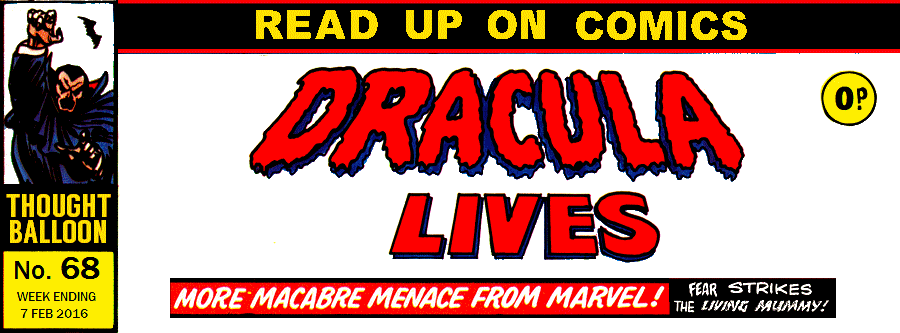 |
| |
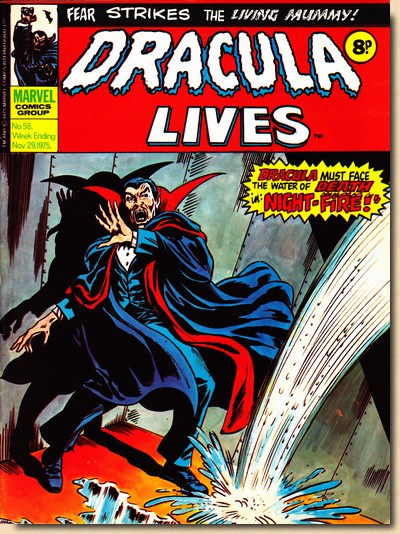 |
|
INSIDE
MARVEL UK's
DRACULA LIVES #58
NOVEMBER 1975
Marvel launched its own UK
imprint operation in late September 1972 with a
comic book which would become both its flagship
title and its publication credo and motto:
the Mighty World of Marvel.
Edited in the US but printed
in the UK to a larger format than American Marvel
comic books, the 40 page Mighty World of
Marvel #1 kicked off a row of highly
successful years for what would soon be known as
"Marvel UK".
|
|
| |
| By
mid-1974, the success of Marvel UK's first three weeklies
had the powers in charge look to further expansion, and
this move would - at the height of the popularity and
importance of the horror and fantasy genres for the US
market - almost inevitably point to additional material
which would complement the so far superhero-only
publications. The move happened on 26 October 1974 when
two new weeklies were launched simultaneously: Dracula
Lives! and Planet of the
Apes. |
| |
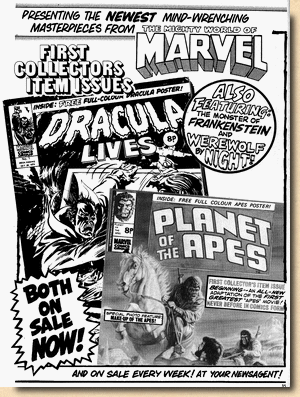
|
|
Marvel had supplemented its
classic superheroes with other genres in the US
as the "House of Ideas" progressed from
the 1960's "Silver Age" to the 1970's
"Bronze Age", and Marvel's newly
created range of
horror characters played a substantial and
important role in this expansion. Marvel's most
successful venture into the realm of horror was
the introduction of Dracula, Bram Stoker's
classic "Lord of Vampires", to the
ranks of Marvel's characters. Given his own title
straight away in April 1972, Tomb of
Dracula (the extension
to the vampire count's name was necessary for
Marvel to be able to copyright the title)
ultimately ran for a total of 70 issues in the US
- the longest run of any Bronze Age Marvel horror
genre title.
Tomb of Dracula was
therefore a a logical choice for Marvel when it
came to expanding its range of weeklies in the
UK. However, in a slightly confusing move, the
reprints of Tomb of Dracula were
launched in Great Britain under the title of Dracula
Lives (which was in fact the title of a
black and white magazine format comic book
featuring the count which Marvel was publishing
since June 1973).
Ads
in Marvel UK's superheroes titles heralded Dracula
Lives! and Planet of the Apes
together, and this "twinning" of the
two titles in ads would continue right up until
the two weeklies would be merged in in June 1976.
|
|
| |
| The UK
comic book market of the early to mid-1970s differed
greatly from its counterpart in the US as it was
quintessentially keyed at a weekly interval of
publication, with predominantly black and white contents
and multiple storylines (and therefore often also various
different characters) in one issue. Other than reprints of Tomb
of Dracula as the lead feature, Dracula Lives started
out with back-up material from The
Monster of Frankenstein and
Werewolf by Night. As the fairly short-lived
Frankenstein material came to an end, this slot was
filled with the Living Mummy as of Dracula Lives
#42 in August 1975 in order to keep up the established
formula with "three macabre masterpieces every
issue". The weekly publication schedule resulted in a
pronounced volatility of the UK comic book market in
comparison to monthly or even bi-monthly installments,
and only four months later the title of Marvel UK's
horror weekly was expanded as of issue #60 in December
1975 to Dracula Lives featuring The Legion of
Monsters - with no change to its featured contents.
So let's
take a closer look at the black and white content behind
the glossy cover of Dracula Lives #58, which
went on sale in the UK on 23 November 1975.
|
| |

"The
Origin of the Chimera!"
Originally published
in Tomb
of Dracula #26 (July
1976)
Original
story title: "Where Lurks the
Chimera!"
Script - Marv
Wolfman
Pencils - Gene Colan
Inks - Tom Palmer
Lettering - John
Costanza
Original page count:
17
Reprinted pages: 6 (plus Marvel UK splash
page)
|
|
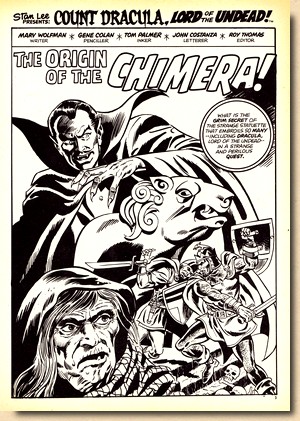
|
|
|
| |
| Dracula
Lives #58 reprints the last third
of Marv Wolfman's first part in a three issues story arc
featuring the mysterious "Chimera" - a powerful
magical artefact in the form of a statue of the mythical
beast of the same name (with a lion's head, a goat's body
and a snake's tail), made up of three individual
pieces and capable of transforming the thoughts of
whoever possesses all three pieces into reality. |
| |
| Two parts of the
statue have been stolen from a pawnshop,
and Dracula is among those seeking to
track them down. Having learned where
they are kept from one of his informants,
the Lord of Vampires enters the mansion
pointed out to him but soon finds himself
trapped behind steel doors. A mysterious
voice instructs Dracula over a
loudspeaker system where to go. Playing
along for the moment, Dracula is thus
directed into a room, where the voice
tells him that he must die for seeking
the power of the Chimera. Only seconds
later more sliding steel doors trap
Dracula, and as the enraged Count
considers his next steps, a panel in the
ceiling suddenly slides open to release a
stream of water onto the floor, and as
Dracula realizes in terror that the
liquid is actually holy water, he is
seemingly trapped with no way of escaping
this deadly threat... The
weekly publication schedules of Marvel's
British output created a need for covers
and splash pages at very frequent
intervals as the original US material was
split up over two or three UK issues.
This was not required for the end panel
in this case, as the original material
took care of pointing readers to what lay
in store next. However, both a cover and
a splash page were needed for Dracula Lives #58,
and both are rather disappointing. In all
fairness it was a tough task bordering on
the impossible to emulate the majestic
artwork of Gene Colan, but blowing up
panels with original Colan artwork would
certainly have rendered more appropriate
artwork.
|
|
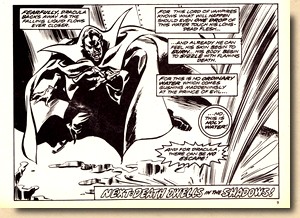
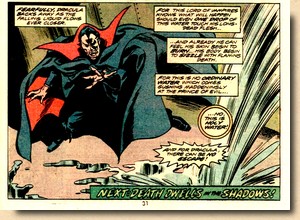
|
|
|
| |
| It must be
remembered, however, that most of the young
readership at the time was probably not as finely
tuned in to differences in artwork as today's
adult afficionados are. Blowing up artwork
through xeroxing wasn't cheap either back in
those days, so having a staffer at Marvel's NYC
offices pencil and ink the required pieces was a
convenient way to go. Other than that, both the
story and artwork from this phase of Tomb of
Dracula are truly classic material of the
highest quality.
"A lot of us
back then were trying to break out of comics
just for kids, and it was very possible for
us to do those things on the non-superhero
books, because no one was paying attention.
So Roy Thomas could do that on Conan, Steve
[Englehart] could do that on Doc Strange and
Master of Kung-Fu, [Steve] Gerber could do it
on Man-Thing or Howard the Duck, and I could
do it on Dracula [...] to try and push comics
into other things, other areas, that they had
not explored (...) Gene's
artwork certainly is the reason why we could
do a lot of that stuff."
(Marv Wolfman in: Siuntres, 2006)
|
|
| |
| |

"Bullet
for a Werewolf"
Originally published
in Werewolf By Night #23 (November
1974)
Original
story title: "The Murder is a
Maniac"
Script - Doug
Moench
Pencils - Don Perlin
Inks - Vince Coletta
Lettering - Artie Simek
Original page count:
17
Reprinted pages: 9 (plus Marvel UK splash
page)
|
|
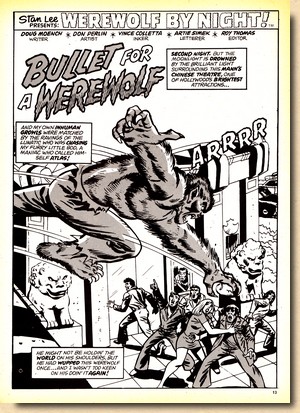
|
|
|
| |
| One of Marvel's most
successful horror characters,
"Werewolf by Night" made his
first appearance in Marvel Spotlight
#2 (one of Marvel's tryout magazines) in
February 1972. A creature rooted in
centuries of traditional folkore in
Europe, it was often portrayed as being
innocent at heart and suffering from an
unhappy personal fate - which was exactly
what Marvel's werewolf was all about as
the series focussed on Jack Russell,
whose family (originally from Eastern
Europe) was cursed with lycanthropy, i.e.
the "curse of the werewolf".
Starting on his 18th
birthday, Russell would find himself
transforming into a wolf-like creature
every time there was a full moon. Similar
to Bruce Banner and the Hulk, Jack
Russell would always be seeking ways to
either avoid or at least control the
transformations, and eventually he would
gain the ability to change into the
werewolf at will and control the beast,
except on three specific nights of the
full moon when, in the tradition of
Marvel's "hero with a flaw",
nothing goes. Originally
scripted by Gerry Conway and pencilled
and inked by Mike Ploog, the character
was well received by readers, and Werewolf
by Night ultimately became Marvel's
second most successful venture into the
horror genre, again making it a logical
choice for Marvel UK's Dracula Lives.
Reprinting the second
half of Werewolf by Night #23,
this instalment started out with a splash
page produced by taking the cover from
that US issue, although this did not
yield any consistency in the artwork
either as the cover had been pencilled by
Ron Wilson whereas the interior art was
by Don Perlin. Nevertheless it made for a
slick splash page which also gave readers
a recap of "what happened
previously..." thanks to additional
exposition provided by editorial. This
was a frequently applied procedure, set
up to avoid an all too abrupt entry for
readers into what was in fact a mere
segment of an original flow of events.
Again, no special
editorial attention was needed on the
last page as the "next issue"
pointer from the original material could
be used without any need for alterations.
|
|
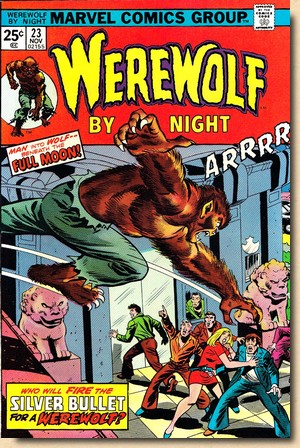
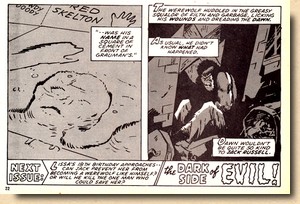
|
|
|
| |
| A
glimpse into the production process for Marvel UK^s
weekly can be glanced from the central spread page which
features a hand-written mark-up reading DRAC58 -
it is in fact a mirror image, indicating that the
material had been marked on the reverse "shooting
film" for the printing process. |
| |
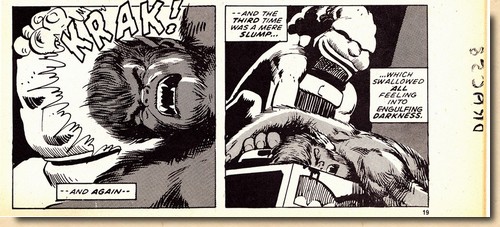 |
|
On
board since the very first issue, Werewolf by Night
would end his run in Dracula Lives
#78 and be replaced in April 1976 by
Ghost Rider. This was a rare
example of a feature being dropped
(without the weekly it ran in being
cancelled) before Marvel UK ran out of
original material to reprint. In the US, Werewolf
by Night continued its publication
run up until issue #43 before bowing out
in March 1977.
|
|
|
| |
| |

"All these
Great Pawns"
Originally published in Supernatural
Thrillers #14 (August 1975)
Original story
title: "All these Great Pawns"
Script - John Warner
& Val Mayerik (co-plot)
Pencils - Val Mayerik
Inks - Al McWilliams
Lettering - John Costanza
Original
page count: 18
Reprinted pages: 10
|
|
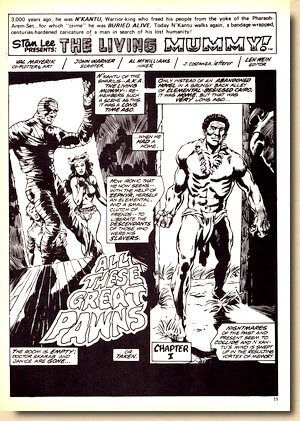
|
|
| |
| In mid-1973 Stan Lee
wanted to complete Marvel's rendition of
the classic Universal Horror Cabinet from
the 1930s and thus called for Marvel's
own Mummy character (Cooke, 2001). Again,
as with Dracula, a tag-on was needed in
order to be able to copyright the
character, so the House of Ideas came up
with The Living Mummy and a
background plot which follows the
underlying motives of most Mummy stories:
an innocent and well meaning individual
is punished unjustly by being mummified
alive, comes back to life, and seeks out
revenge.
Appearing for the
first time in August 1973 in Supernatural
Thrillers #5, Steve Gerber's
storyline featured a noble African tribal
prince called N'Kantu who - together with
the members of his tribe - is defeated
and enslaved by the Ancient Egyptians.
Forced to work on monuments for the
pharaoh, N'Kantu plans and leads a
rebellion which ultimately fails and for
which he is punished by the high-priest
Nephrus by being mummified and buried
alive, his blood drained and replaced
with an unknown alchemical preservative.
3,000 years later
N'Kantu regaines control from his
paralyzing fluid and digs himself free to
wreak havoc on those that had wronged
him, going on a murderous rampage in
Cairo until he locates Dr Alexi Skarab
who is a descendant of Nephrus...
|
|
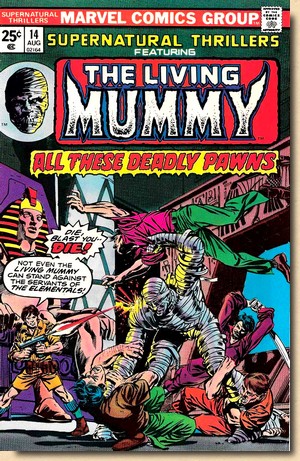
|
|
|
| |
| When
N'Kantu returned in Supernatural Thrillers #7
Val Mayerik (who was occasionally also credited as
co-plotter) took over the pencilling from Rich Buckler,
and Gerber brought the character to New York City before
handing over the writing to Tony Isabella, who took care
of the series until Supernatural Thrillers was
cancelled after issue #18 in October 1975. Once shipped
to a New York museum, N'Kantu awakens again, and the rest
of the The Living Mummy story arc centers on
N'Kantu regaining his memory and his ensuing conflict
with the Elementals - four extradimensional humanoids who
use the mummy as a pawn against a foe called the Living
Pharaoh to obtain the Ruby Scarab (which grants special
powers to its bearer) - which is also pretty much what is
going on in the story segment featured in this issue of Dracula
Lives. |
| |
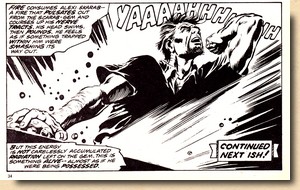 |
|
Once
again, reprinting the first half of an original
US issue meant that the original splashpage was
at hand, requiring only the removal of the credit
for the colouring. The final panel of this
instalment was just as easy, as a plain CONTINUED NEXT ISH! blurb sufficed. As writers
and artist would often try to pace their pages in
a way which provided something of a minor
cliffhanger before readers turned to the next
page, this segmentation in the UK weeklies often
worked quite seamlessly and hardly ever left
readers with the impression of the story having
been "cut off" at random.
|
|
| |
| The only
real problem Marvel UK faced was the fact that they very
quickly began to run out of Living Mummy material
(first introduced to UK readers in Dracula Lives
#42) as it had enjoyed a rather short publication span in
the US. This created a need for further Marvel horror
genre characters, and the Living Mummy had its curtain
call in end his run in Dracula Lives
#62 it was replaced the following issue by Man-Thing in
January 1976). |
| |
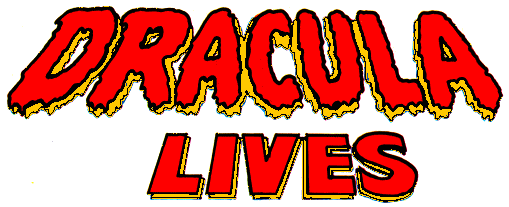
|
| |
| A surprising number of
pages was given over to editorial, and no less than two
featured so-called "pin-ups" - which you either
saw as a great mini-poster or a cheat page filler. |
| |
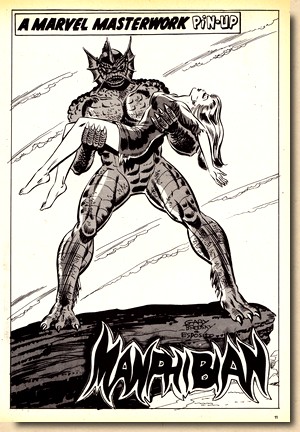
|
|
Either way, UK readers had
never before seen Manphibian, although his
"creature from the black lagoon"
heritage was more than obvious. He first appeared in
September 1975 in Marvel's US black &
white magazine format Legion of Monsters
#1 (there never was a second issue).
The Frankenstein
Monster, however, was well known to Marvel UK
readers of Dracula Lives.
Mary Shelley's most
classic of all monsters had featured in the pages
of "Britain's no.1 fear mag" since
issue #1 - until Marvel UK ran out of original
material to reprint.
|
|
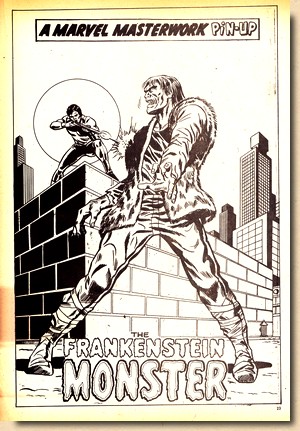
|
|
| |
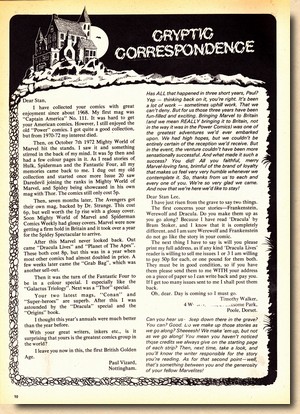 |
|
The
letters page in Dracula Lives was named Cryptic
Correspondence, which was a somewhat typical
play on the word "crypt" for the Marvel
tongue-in-cheek editorial house style. The two letters printed in
this issue are excellent examples to illustrate
how different a world the 1970s were for comic
book readers when it came down to knowing your
"Marvel facts".
Rather than having
access to a global information network via the
internet, very often the only source to become
informed were the comic books themselves. Bullpen
bulletins (of which there was none in Dracula
Lives #58) often provided some background
information on Marvel as a publisher, the
creators involved, and what else was going at
Marvel UK - which sometimes came as a surprise
because not all news agents would carry all
Marvel UK titles.
And then there was,
at times, something to be gleaned from seasoned
fans who wrote in to the letters page. In this
case, reader Paul Vizard from Nottingham provided
a personal but at the same time accurate and
matter of fact history of Marvel UK - where else
could you have learned that the comics you maybe
had just been reading for a few months went back
to October 7th 1972 and Mighty World of
Marvel #1?
|
|
| |
| Clearly, this kind of
information always came along in a haphazard way and by
pure happenstance, and it was as easy as anything to miss
it (e.g. if you read MWOM but not Dracula Lives).
Which also explains why some readers - such as Timothy
Walker from Poole in this issue - were asking questions
which would be dismissed as totally uninformed today but
back in the 1970s very often were, indeed, good questions
- in this case noting that the stories involving Dracula,
Frankenstein and the Werewolf deviated from their
original literary sources and wondering why and how this
came to be. |
| |
| In-house adverts very often
were an excellent source of information too, and would
occasionally introduce readers to Marvel characters they
simply hadn't seen before - or the fact that there were
annuals. All of this was on offer to readers of Dracula
Lives #58, plus a glimpse of the new feature soon to
replace the Mummy stories (which no doubt would also
trigger some reader's question why these were not being
continued, blissfully unaware of the fact that these were
all reprint comics and that there simply weren't any more
Mummy stories available). |
| |
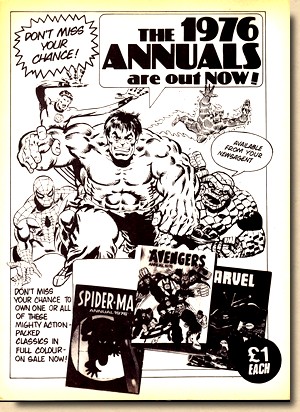 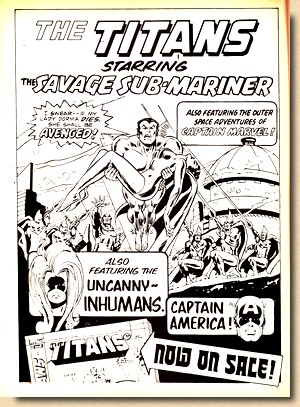 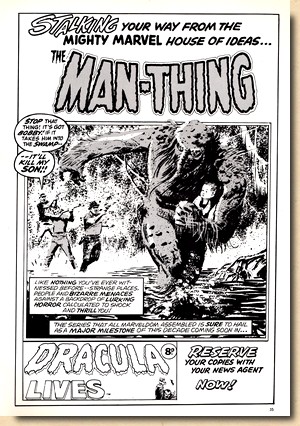 |
| |
| Just as
Marvel was exporting a number of their US comics to the
British market (known as "pence price variants" because they
carried a UK currency price printed on their covers) they
would also make available their oversize 10" x 14" "Treasury
Edition" Giant Superhero Holiday Grab-Bag. Although itself a
comic book featuring only reprinted material, these had
nothing to do with Marvel UK; they were entirely produced
in the US, printed in colour and shipped to the UK -
exactly the same product which US readers would be able
to buy (other than the 50p price on the cover).
|
| |
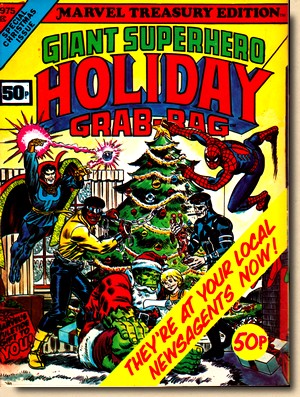
|
|
The 1975 edition was
the second such Holiday Grab-Bag
and featured a themed cover by
John Romita and stories featuring the
characters shown on the cover (although
only the Nick Fury and the Luke Cage
segments really had any relation to
Christmas). And then, the only
third party advertisement in this issue
of Dracula Lives, is a foray
into the picture card series published by
Brooke Bond Tea.
From 1954 up
until 1999, Brooke Bond tea packets
included one of usually 50 illustrated
cards which made up a series which could
be glued into landscape size booklets
with additional text and graphics.
|
|
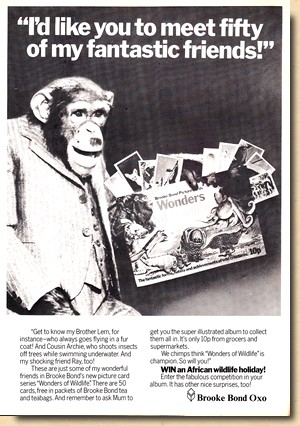
|
|
|
| |
| Most of the series were
wildlife-based (such as the one advertised here),
although personally I much prefered the Prehistoric
Animals (think Dinosaurs) and History of
Aviation, both from 1972. As for Dracula Lives, the
end came not by way of a stake but the bleak UK economy
of 1976 and a subsequently struggling comics book market.
In June
1976 Dracula Lives was cancelled as a weekly
title and merged with Planet of the Apes as of
issue #88. It was not the end of the Count, who would
continue to appear first in POTA (which then officially
became Planet of the Apes and Dracula Lives) and
then later on, after the demise of that weekly, from time
to time in the flagship title Mighty World of Marvel.
Just as it had done in the US, the horror genre went into
a steady and fast decline at Marvel, and all that remains
of the one and only Marvel UK 1970s horror-only title is
but a ghostly spectre in the form of now 40+ years old
copies of Dracula
Lives.
|
| |


More on
Marvel UK in 1975:
1975
- 1977 : EXPANSION, MERGERS - AND CAPTAIN BRITAIN !
|
| |
| |
|
| |
| BIBLIOGRAPHY COOKE
Jon B. (2001) "Son of Stan:
Roy's Years of Horror", Comic Book
Artist # 13, Two Morrows Publishing
SIUNTRES
John (2006) Marv Wolfman by Night,
transcribed from the podcast Word Balloon: The Comic
Creator's Interview Show , available online at
wordballoon.libsyn.com
|
| |
Uploaded
to the web 1 February 2016
Text is copyright (c) 2016

|
|
| |



























